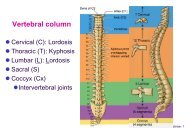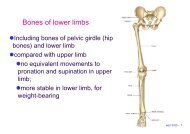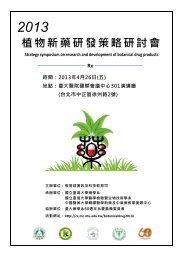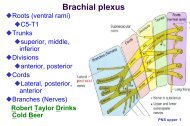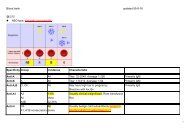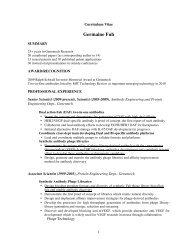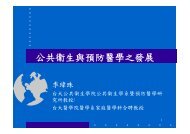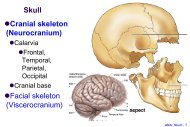暑期生技課程電顯演講 - 台大醫學院
暑期生技課程電顯演講 - 台大醫學院
暑期生技課程電顯演講 - 台大醫學院
Create successful ePaper yourself
Turn your PDF publications into a flip-book with our unique Google optimized e-Paper software.
基因體與蛋白質體醫學<br />
基因產物在細胞之超微結構分析<br />
17/08/2006 10:00 -12:20<br />
盧國賢<br />
國立台灣大學醫學院<br />
解剖學暨細胞生物學科(研究所)<br />
基因產物在細胞之超微結構分析<br />
• 基因產物: DNAs, RNAs, Proteins<br />
• 超微結構分析:<br />
– 電子顯微鏡 –TEM & SEM<br />
• Negative staining – DNAs, RNAs,<br />
• Immuno-electron microscopy – proteins,<br />
• Freeze fracture – intramembranous structures<br />
• Rotary shadowing – filaments (proteins)<br />
– Cryo-EM<br />
– 原子力顯微鏡 (Atomic force microscopy)<br />
1
電子顯微鏡 –<br />
1. TEM (transmission electron<br />
microscopy) 穿透式<br />
2. SEM (scanning electron<br />
microscopy) 掃瞄式<br />
Reference:<br />
1. Bozzola J.J. and Russel L.D. (1999) Electron microscopy<br />
2 nd ed., Jones and Bartlett Publisher, Sudbury,<br />
Massachusetts, USA<br />
2. Sommerville J and Scheer U (1987) Electron microscopy in<br />
molecular biology, a practical approach. ILR Press, Oxford<br />
1 Angstrom<br />
10 Angstroms<br />
1000 nanometers<br />
1000 micrometers<br />
1000 mililimeters<br />
Linear Equivalents<br />
= 0.1 nanometer<br />
= 1.0 nanometer (nm nm)<br />
[formerly millimicron (mμ)]<br />
= 1.0 micrometer (μm)<br />
[formerly micron (μ)]<br />
= 1.0 millimeter (mm)<br />
= 1 meter (m)<br />
1. Resolution (resolving power)<br />
2. Numeral Aperture<br />
3. Focal depth<br />
4. Field depth<br />
2
camera<br />
n =1.5, sin 64°=0.9, λ=380 nm (UV), then<br />
d = 0.172μm 0.2μm<br />
解像力<br />
(Resolution)<br />
Resolving power<br />
解像力 (Resolution)<br />
Resolving power<br />
The ocular lens of<br />
microscope does not<br />
really affect the<br />
“resolution”.<br />
3
Human naked eyes<br />
SEM<br />
TEM<br />
Theoretical<br />
Resolution of eye versus instrument<br />
Birght field microscope<br />
Tissue section<br />
Distance between<br />
Resovable points<br />
0.2 mm<br />
0.2 μm<br />
0.2 nm<br />
0.2 nm<br />
0.005 nm<br />
1.0 nm<br />
電子顯微鏡之構造與基本原理 (TEM及SEM)<br />
電子顯微鏡標本之基本製作 (TEM切片及SEM標本)<br />
電子顯微鏡術在細胞分子生物學之應用<br />
TEM之構造與基本原理<br />
(Principle of TEM)<br />
TEM之標本製備<br />
(Specimen preparation for TEM)<br />
4
掃瞄式電子顯微鏡之構造與基本原理<br />
Transmitted electrons<br />
5
Lens system<br />
Imaging system<br />
Image recording<br />
system<br />
Specimen<br />
changing system<br />
Vacuum System<br />
Power<br />
Supply<br />
6
Specimen Preparation for Electron Microscopy<br />
Fixation Buffer wash Postfixation<br />
4% Paraformadehyde,<br />
2.5% glutaraldehyde<br />
TEM<br />
Transition fluid<br />
Propylene oxide<br />
Infiltration<br />
Embedding<br />
Epoxy resin<br />
Thin section and staining<br />
Phosphate, cacodylate<br />
pH 7.4 - 7.6<br />
Alcohol dehydration<br />
1% OsO 4<br />
SEM<br />
Critical point dryer (CPD)<br />
Alcohol, acetone<br />
Sputter coating (Au+C)<br />
Mounting on the Stage<br />
4% paraformaldehyde, Karnovsky fixative (2% paraform- paraform & 2% glutar-aldehyde<br />
glutar aldehyde)<br />
7
Ultra-microtome<br />
8
1. Uranyl acetate<br />
2. Lead citrate<br />
1μm thick plastic (epxoy resin) section, toluidine blue stain<br />
9
Hepatic sinusoid 70nm thin section, uranyl acetate & lead citrate<br />
電子顯微鏡之構造與基本原理 (TEM及SEM)<br />
電子顯微鏡標本之基本製作 (TEM切片及SEM標本)<br />
電子顯微鏡術在細胞分子生物學之應用<br />
SEM之構造與基本原理<br />
(Principle of SEM)<br />
SEM之標本製備<br />
(Specimen preparation)<br />
10
Basic Principle & Components of<br />
Scanning Electron Microscope<br />
1. Secondary electrons,<br />
2. Scanning devices,<br />
3. CRT – recording devices<br />
I. Main body (Column)<br />
1. Illuminating system<br />
2. Specimen chamber<br />
3. Image forming system<br />
4. Image recording system<br />
II. Vacuum System<br />
III. Electric System<br />
IV. Cooling system<br />
掃瞄式電子顯微鏡之構造與基本原理<br />
11
本學科電子顯微鏡:<br />
JSM-T330A (1989)<br />
加速電壓:5-30 KV<br />
解像力:10 nm<br />
12
Specimen Preparation for Electron Microscopy<br />
Fixation Buffer wash Postfixation<br />
4% Paraformadehyde,<br />
2.5% glutaraldehyde<br />
TEM<br />
Transition fluid<br />
Propylene oxide<br />
Infiltration<br />
Embedding<br />
Epoxy resin<br />
Thin section and staining<br />
Alcohol dehydration<br />
-56°C and 75p.s.i.<br />
(5.10 atm)<br />
Phosphate, cacodylate<br />
pH 7.4 - 7.6<br />
1% OsO 4<br />
SEM<br />
Critical point dryer (CPD)<br />
Alcohol, acetone<br />
Sputter coating (Au+C)<br />
Mounting on the Stage<br />
31°C and 1073p.s.i.<br />
(72.9 atm)<br />
13
CPD dried air dried<br />
Critical Point<br />
Dryer<br />
14
Sputter Ion<br />
Coater- Au<br />
Stubs (specimen stage)<br />
Evaporator --C<br />
15
• A negative staining technique<br />
uses heavy metal salts to<br />
enhance the contrast<br />
between the background and<br />
the virion's image.<br />
Negative staining<br />
Negative stain of rotavirus<br />
16
Negative staining<br />
1. Negative staining<br />
17
Electron Micrograph of Coliphage T4<br />
18
Immunoelectron microscopy<br />
• This technique allows the<br />
investigator to identify<br />
antibody/antigen complexes<br />
that localize to a particular<br />
subcellular organelle or<br />
compartment by using the<br />
Protein A gold technique.<br />
Protein A gold labeling of a prostatic<br />
endocrine-paracrine cell demonstrating<br />
localization of calcitonin (inset) to the<br />
neuroscretory granules.<br />
3. Immuno-EM<br />
19
The portion of the cell on the left (M) is a 'mammotroph' cell; note the presence of the<br />
larger gold particle size over the prolactin-containing secretory granules. The other cell<br />
profile (S) is a 'somatotroph' cell; note that the growth hormone-containing secretory<br />
granules are labelled with the smaller gold particles.<br />
Vesicle fraction from squid axoplasmic cells were subjected to<br />
gold-bead-conjugated kinesin or myosin V proteins. Small<br />
beads are kinesin, larger beads are myosinV<br />
20
Rotary shadowed replicas<br />
• Rotary shadowed replicas allow surface<br />
detail to be imaged at high resolution. The<br />
sample is dried and then a metal such as<br />
platinum is evaporated onto the surface in<br />
a vacuum. The source of the metal lies at<br />
an angle to the sample surface, so the<br />
thickness of the accumulated metal varies<br />
with the surface topography. This<br />
produces a 3-d effect when the metal<br />
replica is viewed in the TEM.<br />
Rotary shadowed replicas<br />
21
Freeze-fracture<br />
• Freeze-fracture reveals intracellular details<br />
in 3-d. Samples are frozen rapidly in liquid<br />
nitrogen and fractured to reveal internal<br />
structure. The fracture surface is etched<br />
under vacuum and shadowed with metal.<br />
The resulting replica contains fine<br />
morphological detail and is particularly<br />
useful for studies of lipid bilayers.<br />
Replicas are examined in transmission EM.<br />
22
轉180度<br />
23
2% uranyl acetate<br />
轉180度<br />
Negative staining<br />
2. DNA spread and Shadow-casting<br />
Supporting (Formvar) film,<br />
platinum & carbon castings<br />
Electron microscopic analysis of vibriophage N5 virion morphology (2%<br />
uranyl acetate) and DNA structure (DNA mounted on the grid by<br />
Kleinschmidt's technique).<br />
24
Quick-freeze, deep-etch<br />
• Quick-freeze, deep-etch preparation for<br />
rotary shadowing. Samples are rapidly<br />
frozen in liquid nitrogen and transferred to<br />
a vacuum device in which surface ice is<br />
sublimed. This effectively etches the<br />
sample surface, revealing the preserved 3d<br />
structure of the hydrated material. A<br />
rotary shadowed surface replica can then<br />
be obtained.<br />
• Freeze-fracture<br />
Shadow-casting<br />
– Unidirectional shadowing (↙ 45o Pt, ↓90o C)<br />
– Etching is optional<br />
• Shadow-casting – in cells or tissues<br />
– Freeze-fracture,<br />
– deep-etching and<br />
– rotary shadowing – (all directions) – for cells,<br />
tissues & macromolecules,<br />
25
Quick-freezing, Deep-etching, Rotary-shadowing<br />
轉180度<br />
26
Simple shadow-casting<br />
• Quick freeze,<br />
• Cryo-ultracut<br />
↓<br />
Cryo-EM<br />
– Thin section at freezing temperature (-196oC) – Pick up on a formvar-coated copper grid<br />
– Metal-contrast staining or immunostaining<br />
• Examine in an EM<br />
27
1. Cryo-EM<br />
This picture shows an animal virus called ORF, imaged by cryo-EM<br />
28
Cyro-EM<br />
1. Cryo-Electron Cryo Electron Microscopy (cryo ( cryo-EM) EM) is a technique for<br />
getting 3D structures of biological molecules from an<br />
electron microscope.<br />
2. Single-particle cryo-EM gathers many images of the same<br />
particle (molecule or molecular complex) in various<br />
orientations, and then uses something like computed<br />
tomography to reconstruct the 3D structure.<br />
3. Cryo-EM routinely determines structures to about 15<br />
Angstrom resolution, but with enough images (100,000 or<br />
more) resolutions of 7 or 8 Angstroms should be attainable.<br />
4. So a key problem is automatically finding the particle<br />
images inside the micrographs.<br />
Cryo-EM (3D EM – electron tomography)<br />
• The 3D structure of an object in its entirity<br />
is derived from a series of 2D images<br />
recorded of an objected tilted over various<br />
tilt angles. The data collection is tedious<br />
and involves tilting of the specimen in the<br />
electron microscope, correcting for lateral<br />
shift and change of defocus, defocus followed by<br />
taking an image. This cycle is repeated,<br />
typically, over +/- 70 degrees, with 2<br />
degree tilt increments.<br />
29
5. 3D EM – electron tomography<br />
resolution = pi * thickness of sample / number of projections.<br />
30
Cellular<br />
Compartments<br />
Nature Structural Biology 10, 1011 - 1018 (2003)<br />
Reovirus polymerase 3 localized by cryo-electron microscopy of virions at a<br />
resolution of 7.6 Å. By:Xing Zhang et al.,<br />
31
Atomic force microscope<br />
• The atomic force<br />
microscope (AFM) is one of<br />
the most powerful tools for<br />
determining the surface<br />
topography of native<br />
biomolecules at<br />
subnanometer resolution<br />
two dsDNA<br />
molecules<br />
overlapping<br />
each other,<br />
• the AFM allows<br />
biomolecules to be<br />
imaged not only under<br />
physiological<br />
conditions, but also<br />
while biological<br />
processes are at work.<br />
Because of the high signal-to-noise (S/N) ratio, the<br />
detailed topological information is not restricted to<br />
crystalline specimens. Hence single biomolecules<br />
without inherent symmetry can be directly<br />
monitored in their native environment<br />
imaged in contact under isopropanol single DNA strand<br />
32
cytoplasmic side<br />
1.5μm x 1.5μm<br />
nucleolasmic side<br />
33
SUMMARY<br />
電子顯微鏡之構造與基本原理 (TEM及SEM)<br />
Resolution, components of EM, accelerating voltage,<br />
Transmitted electons (TEM), secondary electrons (SEM)<br />
Rotary pump & pirani guage (10 -1 atm) , diffusion pump & penning<br />
guage (10 -4 atm)<br />
Tungsten filaments, LaB 6 , cold field emission,<br />
電子顯微鏡標本之基本製作 (TEM切片及SEM標本)<br />
Thin sections (TEM) double staining, negative staining, spreading<br />
(virus particle)<br />
Critical point dryer (CO 2 ), ion coater,<br />
電子顯微鏡術在細胞分子生物學之應用<br />
Immuno EM – colloid gold labeled-antibody<br />
Freeze-fracture, intramembranous particle (integral protein),<br />
Cryo-Electron Microscopy -<br />
spicemen tilt, lateral shift, change focus, image, image analysis<br />
原子力顯微鏡 AFM (atomic force microscopy)<br />
34



